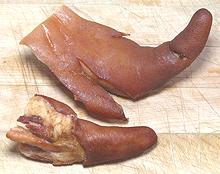
SAFARI
Users
By our current methods, meat is almost never just smoked. It is first cured with salt. Using a dry process, a very small amount of potassium or sodium nitrate (saltpeter) is added to the salt to enhance flavor, produce an attractive color and protect the meat from bacteria. Using a wet process, an even smaller amounts of sodium or potassium nitrite is used for the same purpose.
Bacon
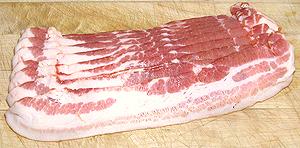 Perhaps the most popular and flavorful cured pork product is bacon -
salt cured and usually smoked pork belly, Many favor it with an almost
religious devotion. There is also Back Bacon, called "bacon" in the
British Isles and much of Canada, and called "Canadian bacon" here. It is
more like a bland ham than like real bacon and is not worthy of religious
devotion, but is sometimes an acceptable breakfast ingredient if not
overcooked. There are other kinds as well, including Chinese and
Hungarian bacon, so bacon is a large subject and has its own
Bacon page.
Perhaps the most popular and flavorful cured pork product is bacon -
salt cured and usually smoked pork belly, Many favor it with an almost
religious devotion. There is also Back Bacon, called "bacon" in the
British Isles and much of Canada, and called "Canadian bacon" here. It is
more like a bland ham than like real bacon and is not worthy of religious
devotion, but is sometimes an acceptable breakfast ingredient if not
overcooked. There are other kinds as well, including Chinese and
Hungarian bacon, so bacon is a large subject and has its own
Bacon page.
Ham
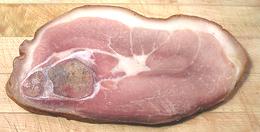 Ham is properly a pig's hind leg, but the term is also sometimes used for
cured shoulder. It may be fresh, but is most often cured in salt brine
and may then be smoked. Hams are cured throughout most of the world,
including China, but excepting Israel and the Muslim regions. Hams are a
major subject and have their own Hams
page.
Ham is properly a pig's hind leg, but the term is also sometimes used for
cured shoulder. It may be fresh, but is most often cured in salt brine
and may then be smoked. Hams are cured throughout most of the world,
including China, but excepting Israel and the Muslim regions. Hams are a
major subject and have their own Hams
page.
Smoked Ham Hocks
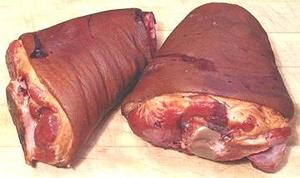 These are available in the refrigerated cases of most well stocked markets
as they are still much favored in the American South. They take a fair amount
of cooking to be edible and are often used as a flavoring ingredient in
soups and stews. Personally I like to boil them up, then refrigerate them
and use them as snacks, cutting off a piece now and then. Find more detail
and cooking information see our
Ham Hocks page.
These are available in the refrigerated cases of most well stocked markets
as they are still much favored in the American South. They take a fair amount
of cooking to be edible and are often used as a flavoring ingredient in
soups and stews. Personally I like to boil them up, then refrigerate them
and use them as snacks, cutting off a piece now and then. Find more detail
and cooking information see our
Ham Hocks page.
Smoked Pork Loin
 This is a common recipe ingredient. It is much milder than the other
smoked products on this page, lightly cured and lightly smoked. It has
fairly good refrigerated shelf life and will be found in the refrigerated
cases of well stocked meat departments. It is made from the loin, which
is where pork chops come from, so the meat has a relatively mild flavor
itself. This makes for an ingredient that will provide some smoked meat
flavor but not overwhelm a recipe. The photo specimens were 5 inches by
5 inches and 1/2 inch thick. Note that these slices are bone-in, whereas
the very similarly cut Canadian bacon would be without bones.
This is a common recipe ingredient. It is much milder than the other
smoked products on this page, lightly cured and lightly smoked. It has
fairly good refrigerated shelf life and will be found in the refrigerated
cases of well stocked meat departments. It is made from the loin, which
is where pork chops come from, so the meat has a relatively mild flavor
itself. This makes for an ingredient that will provide some smoked meat
flavor but not overwhelm a recipe. The photo specimens were 5 inches by
5 inches and 1/2 inch thick. Note that these slices are bone-in, whereas
the very similarly cut Canadian bacon would be without bones.
Smoked Pork Tongues
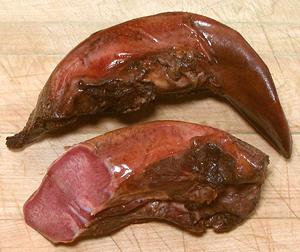 These tongues had both good firm texture and excellent flavor for use as
sliced snacks. They were 6 inches long and weighed 4.2 ounces each.
These were purchased at a large multi-ethnic market in Los Angeles for
US 2015 $5.79 / pound. Made by Mama Vickey's Foods in North Hollywood,
California. Ingred: Pork tongue, salt, cure #1.
These tongues had both good firm texture and excellent flavor for use as
sliced snacks. They were 6 inches long and weighed 4.2 ounces each.
These were purchased at a large multi-ethnic market in Los Angeles for
US 2015 $5.79 / pound. Made by Mama Vickey's Foods in North Hollywood,
California. Ingred: Pork tongue, salt, cure #1.
Smoked Pork Ribs
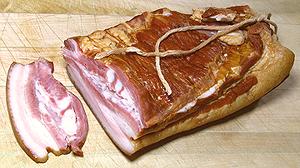 You want flavor? We have flavor, right here. The photo specimen is from
one end of a slice of pork side about 3-3/4 inches wide and 2-1/2 inches
thick. The whole piece was about 14 inches long and cut from the spare
ribs part of the pig. The slice includes the ribs, bacon layer and skin.
It's bacon cured and strongly smoked. Roasted it is awesome. Roasting
method right here: Smoked
Pork Ribs, Roasted.
You want flavor? We have flavor, right here. The photo specimen is from
one end of a slice of pork side about 3-3/4 inches wide and 2-1/2 inches
thick. The whole piece was about 14 inches long and cut from the spare
ribs part of the pig. The slice includes the ribs, bacon layer and skin.
It's bacon cured and strongly smoked. Roasted it is awesome. Roasting
method right here: Smoked
Pork Ribs, Roasted.
Cured Pork Tenderloin
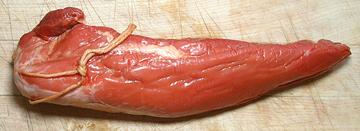 This cut is found on the inside side of the loin and often processed as
a separate part. While the uncured tenderloin is mild in flavor, this
product is meant as a snack item, so the cure is quite distinct and it
ends up tasting similar to a fairly strongly flavored ham. The photo
specimen was 10 inches long, 2-1/2 inches across the big end, and weighed
14-1/8 ounces. Cured with water, garlic, salt, sugar, sodium nitrite.
This cut is found on the inside side of the loin and often processed as
a separate part. While the uncured tenderloin is mild in flavor, this
product is meant as a snack item, so the cure is quite distinct and it
ends up tasting similar to a fairly strongly flavored ham. The photo
specimen was 10 inches long, 2-1/2 inches across the big end, and weighed
14-1/8 ounces. Cured with water, garlic, salt, sugar, sodium nitrite.
Smoked Pig Tails
 These are available in the refrigerated deli cases of well stocked
markets, particularly those serving European or American Southeast
communities. Properly made they have very good flavor and will be
appreciated by people who enjoy gnawing on things. It's best to slice
the skin into bite size squares before starting to gnaw. Tails actually
have a fair amount of meat on them.
These are available in the refrigerated deli cases of well stocked
markets, particularly those serving European or American Southeast
communities. Properly made they have very good flavor and will be
appreciated by people who enjoy gnawing on things. It's best to slice
the skin into bite size squares before starting to gnaw. Tails actually
have a fair amount of meat on them.
Smoked Neck Bones
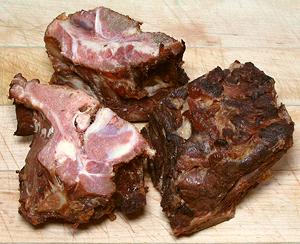 Unlike pig tails, these are not good for gnawing on. They have plenty of
meat but no skin, and the meat is almost impossible to get at until
cooked so well if falls off the bones. These are an excellent ingredient
for flavoring soups and stews. When simmered for 2-1/2 hours or so, the
meat can easily be picked off, returned to the pot, and the bones
discarded. These can be found in the refrigerated deli cases of well
stocked markets, particularly those serving an American Southeast
community.
Unlike pig tails, these are not good for gnawing on. They have plenty of
meat but no skin, and the meat is almost impossible to get at until
cooked so well if falls off the bones. These are an excellent ingredient
for flavoring soups and stews. When simmered for 2-1/2 hours or so, the
meat can easily be picked off, returned to the pot, and the bones
discarded. These can be found in the refrigerated deli cases of well
stocked markets, particularly those serving an American Southeast
community.
